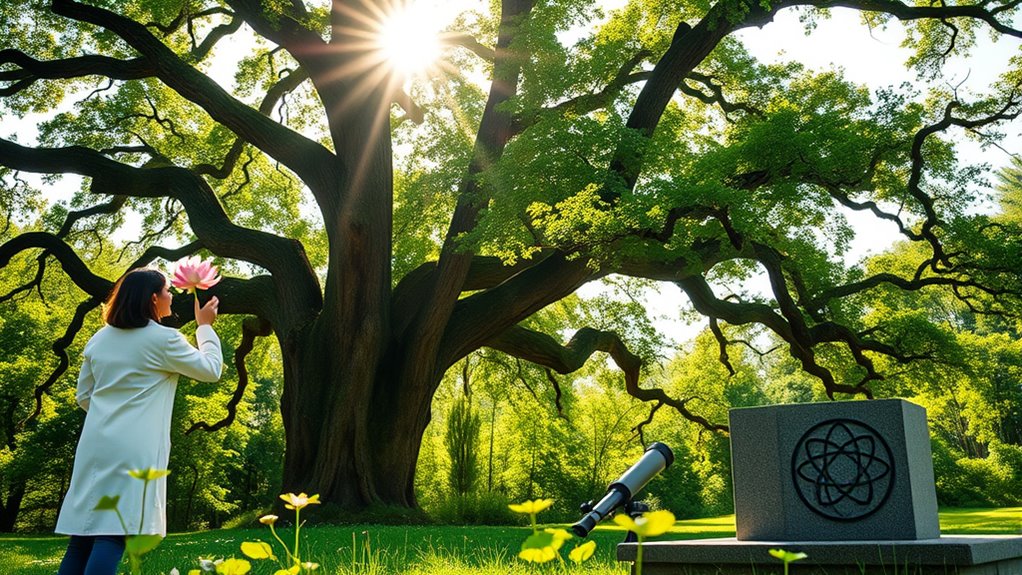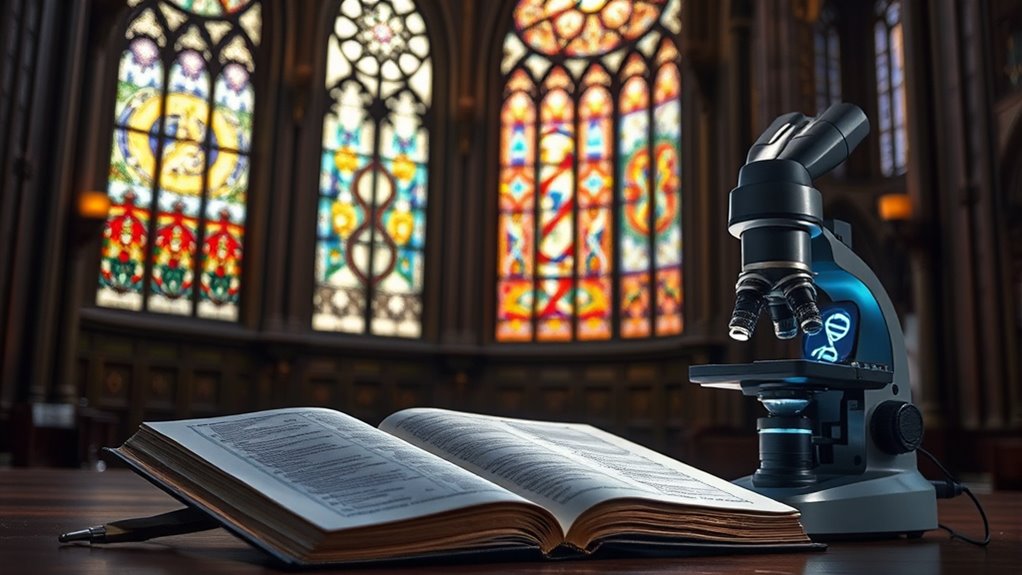Science and faith can definitely coexist because they serve different yet complementary roles in understanding the universe. While science relies on empirical evidence and experimentation, faith is rooted in spiritual belief and moral values. Throughout history, many have found harmony between the two, seeing them as sources of insight rather than conflict. If you’re curious about how this balance works and the common ground they share, there’s much more to explore.
Key Takeaways
- Science relies on empirical evidence, while faith is based on spiritual belief; they operate in different but potentially complementary domains.
- Historical interactions show that science and faith have coexisted, influenced each other, and sometimes found harmony.
- Philosophical perspectives support the idea that science and faith address different questions, making coexistence possible.
- Conflicts often arise when scientific discoveries challenge literal interpretations of religious texts, but reinterpretations can bridge gaps.
- Many individuals and communities integrate science and faith, emphasizing shared values like morality, curiosity, and the pursuit of truth.
Historical Perspectives on Science and Faith

Throughout history, science and faith have often been viewed as conflicting forces, but their relationship is more complex than simple opposition. Many early beliefs about the universe stem from mythical origins, where gods and spirits explained natural phenomena. Over time, theological debates shaped how societies understood creation, morality, and existence, intertwining religion and early scientific thought. During the Middle Ages, religious institutions preserved knowledge, even as scientific inquiry began to challenge traditional views. Some thinkers sought harmony between faith and emerging discoveries, while others saw them as separate spheres. These historical perspectives reveal that science and faith have long influenced each other, sometimes complementing, sometimes clashing, but always contributing to humanity’s evolving understanding of the world.
Points of Tension Between Scientific Inquiry and Religious Beliefs

Points of tension between scientific inquiry and religious beliefs often arise from their differing methods of understanding the world. Scientific methods rely on empirical evidence, experimentation, and testing, while religious beliefs are rooted in faith and spiritual insight. This can lead to epistemological conflicts, where scientific explanations challenge literal interpretations of religious texts. Ethical dilemmas also emerge when scientific advancements, such as cloning or genetic editing, clash with moral or doctrinal standards. You might find yourself caught between accepting scientific findings and honoring religious convictions. These tensions can cause discomfort, especially when scientific theories seem to contradict core beliefs. Recognizing these points of conflict helps you understand why science and faith sometimes appear at odds, even as they seek truth from different perspectives.
Examples of Harmonious Coexistence and Integration

Many individuals and communities find ways to harmonize their scientific understanding with their faith by embracing integration rather than conflict. Interfaith dialogues often promote mutual respect, allowing religious perspectives to inform ethical discussions in science. For example, scientists who are also people of faith may collaborate on research, guided by scientific ethics that prioritize integrity, responsibility, and compassion. These dialogues help bridge gaps, fostering a shared commitment to human well-being and moral principles. Religious groups may support scientific advancements like medical research or environmental conservation, seeing them as expressions of their faith’s values. Such cooperation demonstrates that science and faith can coexist productively, enriching each other and addressing complex issues with a combined perspective rooted in understanding and shared goals.
Philosophical Arguments Supporting Compatibility

Philosophical arguments often support the idea that science and faith are compatible by highlighting their different but complementary ways of understanding truth. In metaphysical debates, many philosophers argue that science addresses the nature of physical reality, while faith explores moral and spiritual realities beyond empirical reach. Epistemological considerations also play a role, emphasizing that knowledge can be classified into different domains—scientific knowledge based on evidence and faith-based knowledge rooted in personal or divine authority. This distinction suggests that science and faith serve separate but interconnected purposes, reducing conflicts. By recognizing these philosophical foundations, you can see how science and faith may coexist, each providing valuable insights into different aspects of human understanding without undermining one another.
Impact of Scientific Discoveries on Religious Worldviews

Scientific discoveries have profoundly influenced religious worldviews by challenging traditional beliefs and prompting reinterpretations of spiritual teachings. The evolution debates, for instance, question literal interpretations of creation stories, leading many to see science and faith as compatible rather than conflicting. Creationism challenges have pushed some believers to reconcile scientific evidence with spiritual beliefs through metaphorical or allegorical understandings. These shifts encourage you to view religious teachings as adaptable rather than fixed. Here’s a quick overview:
| Topic | Challenge | Response |
|---|---|---|
| Evolution debates | Questioning literal creation | Emphasizing spiritual symbolism |
| Creationism challenges | Conflicts with scientific evidence | Interpreting scriptures flexibly |
| Scientific impact | Redefining faith in light of science | Harmonizing beliefs |
This ongoing dialogue reshapes how you perceive faith and science’s roles in understanding existence.
Exploring Personal Narratives of Faith and Scientific Curiosity

Your personal journey often reveals how faith and scientific curiosity shape your understanding of the world. Sharing stories of these experiences highlights the ways spirituality and inquiry coexist in your life. By exploring these narratives, you gain insight into how curiosity and belief can strengthen each other.
Personal Journeys of Faith
Many individuals find that their faith and curiosity about the natural world develop hand in hand, shaping personal journeys that challenge the idea of conflict between science and spirituality. You may have experienced moments like miraculous healing or witnessed divine intervention that deepened your trust in a higher power. These experiences often inspire you to explore how faith complements scientific understanding rather than opposes it. For example:
- Personal encounters with unexplained recoveries
- Developing a sense of purpose through spiritual reflection
- Recognizing harmony between scientific discovery and divine mystery
- Finding comfort in faith during complex scientific questions
Your journey might involve questioning, learning, and ultimately embracing both your spiritual beliefs and scientific curiosity as interconnected facets of your life.
Curiosity and Spirituality
Personal stories often reveal a seamless blend of curiosity and spirituality, where questioning the natural world leads to deeper spiritual reflection. When you experience scientific wonder, you’re driven to explore the mysteries of the universe, sparking spiritual exploration that connects you to something greater. This curiosity fuels your desire to understand how the cosmos functions, yet it also opens your heart to awe and reverence. Scientific discovery becomes more than data; it transforms into a pathway for spiritual growth. Your journey shows that curiosity isn’t separate from faith but intertwined with it, creating a rich narrative of exploration that deepens both your understanding of the world and your connection to the divine. In this way, science and spirituality complement each other beautifully.
Frequently Asked Questions
How Do Different Religions Interpret Scientific Findings?
When exploring how different religions interpret scientific findings, you’ll find substantial interpretation diversity and doctrinal flexibility. Some faiths see science as complementary, embracing discoveries to deepen understanding of divine creation. Others interpret scientific data more cautiously, emphasizing spiritual truths over empirical evidence. Your perspective may vary based on your religion’s teachings, but many believers adapt their views, fostering a dialogue that respects both scientific progress and spiritual beliefs.
Can Faith and Science Provide Complete Answers to Life’s Questions?
Like the shepherd guiding their flock, you seek answers to life’s profound questions. While faith evolution offers spiritual meaning, scientific spirituality explores how belief and evidence intertwine. You might find that science provides explanations for natural phenomena, but faith offers purpose beyond empirical proof. Together, they can complement each other, helping you navigate life’s mysteries without needing to choose solely one path. Both can enrich your understanding and sense of wonder.
What Role Does Education Play in Reconciling Science and Faith?
Education plays a pivotal role in reconciling science and faith through innovative educational approaches and curriculum integration. By exposing you to diverse perspectives, educators help you understand that science explains the natural world, while faith addresses spiritual questions. This balanced approach encourages open-mindedness, allowing you to appreciate both scientific discoveries and spiritual beliefs without conflict, fostering a more holistic understanding of life’s complexities.
Are There Scientific Discoveries That Challenge Religious Doctrines?
Imagine uncovering fossils that challenge traditional Creationism views, sparking intense evolution debates. You see scientific discoveries like DNA evidence supporting common ancestry, which question literal interpretations of religious doctrines. Such findings push you to reconsider how science and faith relate, recognizing that some discoveries challenge certain religious views, yet many believers integrate scientific insights without losing their spiritual beliefs. This ongoing dialogue shapes your understanding of both science and faith’s coexistence.
How Do Young Believers Navigate Conflicts Between Science and Faith?
When you face conflicts between science and faith, you can rely on faith-based reasoning alongside scientific skepticism. You might explore how your beliefs inform your understanding of scientific discoveries, allowing room for both perspectives. Embrace curiosity and ask questions, recognizing that faith can deepen your appreciation of life’s mysteries. By balancing these approaches, you create a personal harmony where science enriches your faith journey rather than opposes it.
Conclusion
Imagine you’re at a crossroads where science and faith meet. Just like Dr. Lisa, who found that her love for astronomy deepened her spiritual understanding, you can see that both can enrich your worldview. When you embrace curiosity without fear of conflict, science and faith become allies, revealing life’s mysteries together. You don’t have to choose one over the other—you can explore both, finding harmony in your pursuit of truth and meaning.










